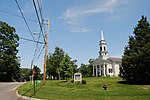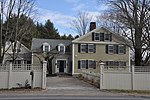Rev. Edmund Dowse House
Greek Revival architecture in MassachusettsHouses completed in 1838Houses in Sherborn, MassachusettsHouses on the National Register of Historic Places in Middlesex County, Massachusetts

The Rev. Edmund Dowse House is a historic house in Sherborn, Massachusetts. The Greek Revival house was built in 1838 for the Rev. Edmund Dowse, the first pastor of the Evangelical Society (now the Pilgrim Church), whose sone, William Bradford Homer Dowse, was a major benefactor of the town. The house was listed on the National Register of Historic Places in 1986.
Excerpt from the Wikipedia article Rev. Edmund Dowse House (License: CC BY-SA 3.0, Authors, Images).Rev. Edmund Dowse House
Farm Road,
Geographical coordinates (GPS) Address Nearby Places Show on map
Geographical coordinates (GPS)
| Latitude | Longitude |
|---|---|
| N 42.238611111111 ° | E -71.365277777778 ° |
Address
Farm Road 21
01770
Massachusetts, United States
Open on Google Maps










